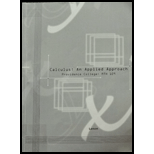
(a)
To calculate: The degree
(b)
To calculate: The Taylor polynomial for the function
(c)
To calculate: The Taylor polynomial for the function
Want to see the full answer?
Check out a sample textbook solution
Chapter 10 Solutions
Calculus: An Applied Approach (Providence College: MTH 109)
- The Cartesian coordinates of a point are given. (a) (-8, 8) (i) Find polar coordinates (r, 0) of the point, where r > 0 and 0 ≤ 0 0 and 0 ≤ 0 < 2π. (1, 0) = (r. = ([ (ii) Find polar coordinates (r, 8) of the point, where r < 0 and 0 ≤ 0 < 2π. (5, 6) = =([arrow_forwardThe Cartesian coordinates of a point are given. (a) (4,-4) (i) Find polar coordinates (r, e) of the point, where r > 0 and 0 0 and 0 < 0 < 2π. (r, 6) = X 7 (ii) Find polar coordinates (r, 8) of the point, where r < 0 and 0 0 < 2π. (r, 0) = Xarrow_forwardr>0 (r, 0) = T 0 and one with r 0 2 (c) (9,-17) 3 (r, 8) (r, 8) r> 0 r<0 (r, 0) = (r, 8) = X X X x x Warrow_forward
- 74. Geometry of implicit differentiation Suppose x and y are related 0. Interpret the solution of this equa- by the equation F(x, y) = tion as the set of points (x, y) that lie on the intersection of the F(x, y) with the xy-plane (z = 0). surface Z = a. Make a sketch of a surface and its intersection with the xy-plane. Give a geometric interpretation of the result that dy dx = Fx F χ y b. Explain geometrically what happens at points where F = 0. yarrow_forwardExample 3.2. Solve the following boundary value problem by ADM (Adomian decomposition) method with the boundary conditions მი მი z- = 2x²+3 дг Əz w(x, 0) = x² - 3x, θω (x, 0) = i(2x+3). ayarrow_forward6. A particle moves according to a law of motion s(t) = t3-12t2 + 36t, where t is measured in seconds and s is in feet. (a) What is the velocity at time t? (b) What is the velocity after 3 s? (c) When is the particle at rest? (d) When is the particle moving in the positive direction? (e) What is the acceleration at time t? (f) What is the acceleration after 3 s?arrow_forward
- Construct a table and find the indicated limit. √√x+2 If h(x) = then find lim h(x). X-8 X-8 Complete the table below. X 7.9 h(x) 7.99 7.999 8.001 8.01 8.1 (Type integers or decimals rounded to four decimal places as needed.)arrow_forwardUse the graph to find the following limits. (a) lim f(x) (b) lim f(x) X-1 x→1 (a) Find lim f(x) or state that it does not exist. Select the correct choice X-1 below and, if necessary, fill in the answer box within your choice. OA. lim f(x) = X-1 (Round to the nearest integer as needed.) OB. The limit does not exist. Qarrow_forwardOfficials in a certain region tend to raise the sales tax in years in which the state faces a budget deficit and then cut the tax when the state has a surplus. The graph shows the region's sales tax in recent years. Let T(x) represent the sales tax per dollar spent in year x. Find the desired limits and values, if they exist. Note that '01 represents 2001. Complete parts (a) through (e). Tax (in cents) T(X)4 8.5 8- OA. lim T(x)= cent(s) X-2007 (Type an integer or a decimal.) OB. The limit does not exist and is neither ∞ nor - ∞. Garrow_forward
- Algebra & Trigonometry with Analytic GeometryAlgebraISBN:9781133382119Author:SwokowskiPublisher:Cengage
